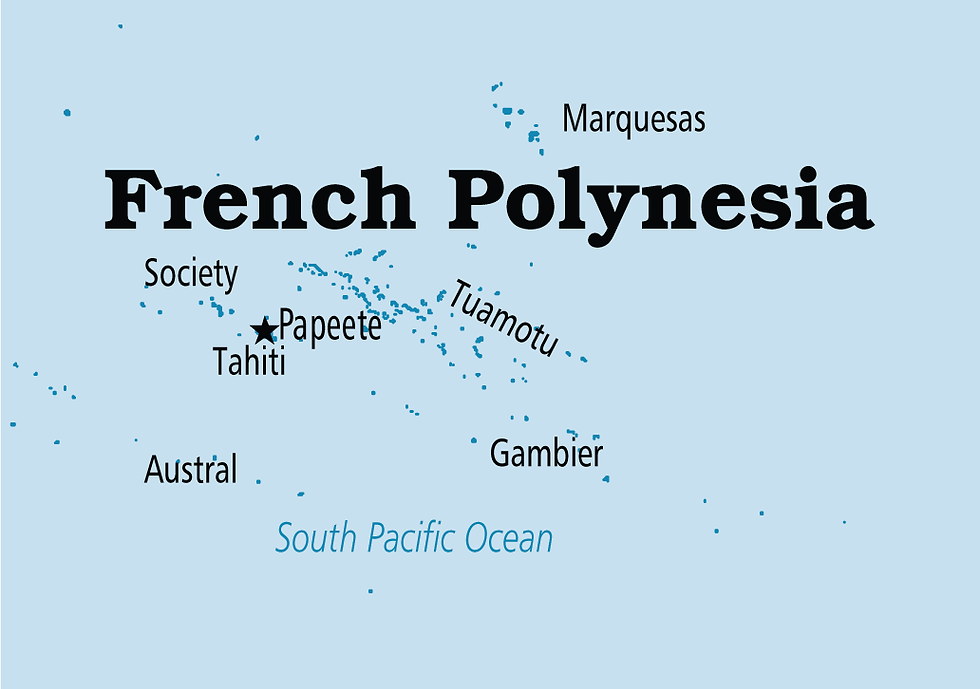French Polynesia
- To-Go

- Jan 10, 2021
- 4 min read
Updated: Oct 1, 2022
Country Name
French Polynesia.
Location
French Polynesia is located in Oceania. It is a group of six archipelagos in the South Pacific Ocean, about halfway between South America and Australia.
French Polynesia is an overseas collectivity of the French Republic and its sole overseas country.
It is divided into five groups of islands: the Society Islands archipelago, composed of the Windward Islands and the Leeward Islands; the Tuamotu Archipelago; the Gambier Islands; the Marquesas Islands; and the Austral Islands. Among its 118 islands and atolls, 67 are inhabited. Tahiti, which is located within the Society Islands, is the most populous island.

Capital
Papeete.
Flag
The flag of French Polynesia was adopted on November 23, 1984. The flag is composed of three horizontal stripes. Two red stripes, one at the top and another at the bottom, border a white strip centered in the flag.
A disc containing the coat of arms of French Polynesia is located in the center of the flag. The coat of arms represents the scene of a Polynesian boat sailing under a bright yellow sun. The red boat occupies the upper center and the lower half is a pattern of blue and white waves. The top half of the disc features 10 golden rays arising from the center. The boat is represented by a crew of five.
The Polynesian sailing boat represents the people, culture, and history of Tahiti and her islands, which is the name used by locals when referring to French Polynesia.
Each crew member depicted inside the canoe represents one of the territory’s island groups. Red and white are the traditional colors of Polynesia. The golden rays represent life while the five rows of waves stand for the territory’s seafaring heritage.
The symbols of the flag and coat of arms reflect the courage, solidarity, and self-sacrifice of the people of French Polynesia.

Language
French is the only official language of French Polynesia.
A law adopted in April 1996 declares French the official language, but Tahitian and several other Polynesian languages can be used.
Religion
Christianity is the main religion of the islands. A majority of 54% belongs to various Protestant churches, especially the Maohi Protestant Church, which is the largest and accounts for more than 50% of the population. It traces its origins to Pomare II, the king of Tahiti, who converted from traditional beliefs to the Reformed tradition brought to the islands by the London Missionary Society.
Currency
CFP franc (XPF).

Time Zone
There are 3 time zones in French Polynesia;
-10:00 GMT.
-09:30 GMT.
-09:00 GMT.
Government Regime
Devolved parliamentary dependency.
Climate
In French Polynesia, the climate is tropical, influenced by the southeast trade winds, with a hot and humid season from November to April and a cooler season from May to October. The temperatures vary a little throughout the year.
In Bora-Bora atoll, the daytime temperature ranges from 30 °C (86 °F) in the warm period to 28 °C (82 °F) in the cool period. In Bora-Bora, the sun shines for a few hours a day even in the wettest period; however, the sunniest period is the least rainy, from June to September.
On the island of Tahiti, the temperatures are similar to those of Bora-Bora, just slightly lower. However, in the interior, there are mountains, so on the west coast (Papeete, Punaauia, Paea), more protected from the trade winds, the temperatures in winter are a little higher than on the eastern one.
In the Marquesas the weather is warm, but above all, they are almost always out of the path of tropical cyclones.
The Austral Islands* are cooler throughout the year: in the Tubuais and the Gambiers, the average temperature ranges from 25 °C (77 °F) in January to 20/21 °C (68/70 °F) in August; this means that the period from December to April is warm but not excessively, while the period from June to September when daytime temperatures are around 24 °C (75 °F), can be a bit cool for swimming and sunbathing.
In the Bass Islands, it's rare to experience hot temperatures, since the average daytime temperature ranges from 27 °C (80 °F) in February and March to 21 °C (69/70 °F) in the period from July to September.
The best time to visit the Society Islands (Tahiti, Bora-Bora) and the Tuamotu Islands runs from June to September, while the best time on the Marquesas Islands runs from August to November.
In contrast, it's hard to find an advisable season for the Austral Islands, in fact, the summer is hot and muggy, with heavy rains and thunderstorms as well as some risk of tropical cyclones, while the winter at this latitude is a bit cool, and even rainy and windy on the southernmost islands.
*The Austral Islands are divided into two groups: the Tubuai Islands (Tubuai, Rimatara, Rurutu, Raivavae, Îles Maria), which are located around the Tropic of Capricorn, and the Bass Islands (Rapa Iti, Marotiri), which lie more to the south; for their southern location












Comments